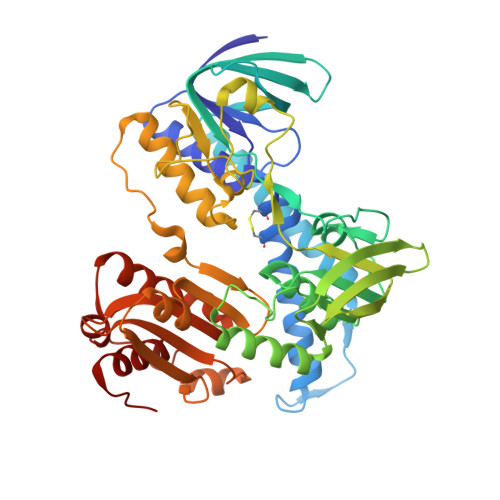Lipoamide channel-binding sulfonamides selectively inhibit mycobacterial lipoamide dehydrogenase.
Bryk, R., Arango, N., Maksymiuk, C., Balakrishnan, A., Wu, Y.T., Wong, C.H., Masquelin, T., Hipskind, P., Lima, C.D., Nathan, C.(2013) Biochemistry 52: 9375-9384
- PubMed: 24251446
- DOI: https://doi.org/10.1021/bi401077f
- Primary Citation of Related Structures:
4M52 - PubMed Abstract:
Tuberculosis remains a global health emergency that calls for treatment regimens directed at new targets. Here we explored lipoamide dehydrogenase (Lpd), a metabolic and detoxifying enzyme in Mycobacterium tuberculosis (Mtb) whose deletion drastically impairs Mtb's ability to establish infection in the mouse. Upon screening more than 1.6 million compounds, we identified N-methylpyridine 3-sulfonamides as potent and species-selective inhibitors of Mtb Lpd affording >1000-fold selectivity versus the human homologue. The sulfonamides demonstrated low nanomolar affinity and bound at the lipoamide channel in an Lpd-inhibitor cocrystal. Their selectivity could be attributed, at least partially, to hydrogen bonding of the sulfonamide amide oxygen with the species variant Arg93 in the lipoamide channel. Although potent and selective, the sulfonamides did not enter mycobacteria, as determined by their inability to accumulate in Mtb to effective levels or to produce changes in intracellular metabolites. This work demonstrates that high potency and selectivity can be achieved at the lipoamide-binding site of Mtb Lpd, a site different from the NAD⁺/NADH pocket targeted by previously reported species-selective triazaspirodimethoxybenzoyl inhibitors.
Organizational Affiliation:
Department of Microbiology and Immunology and ‡Department of Pharmacology, Weill Cornell Medical College , New York, New York 10065, United States.
















